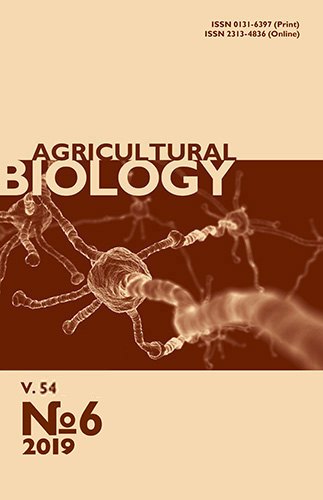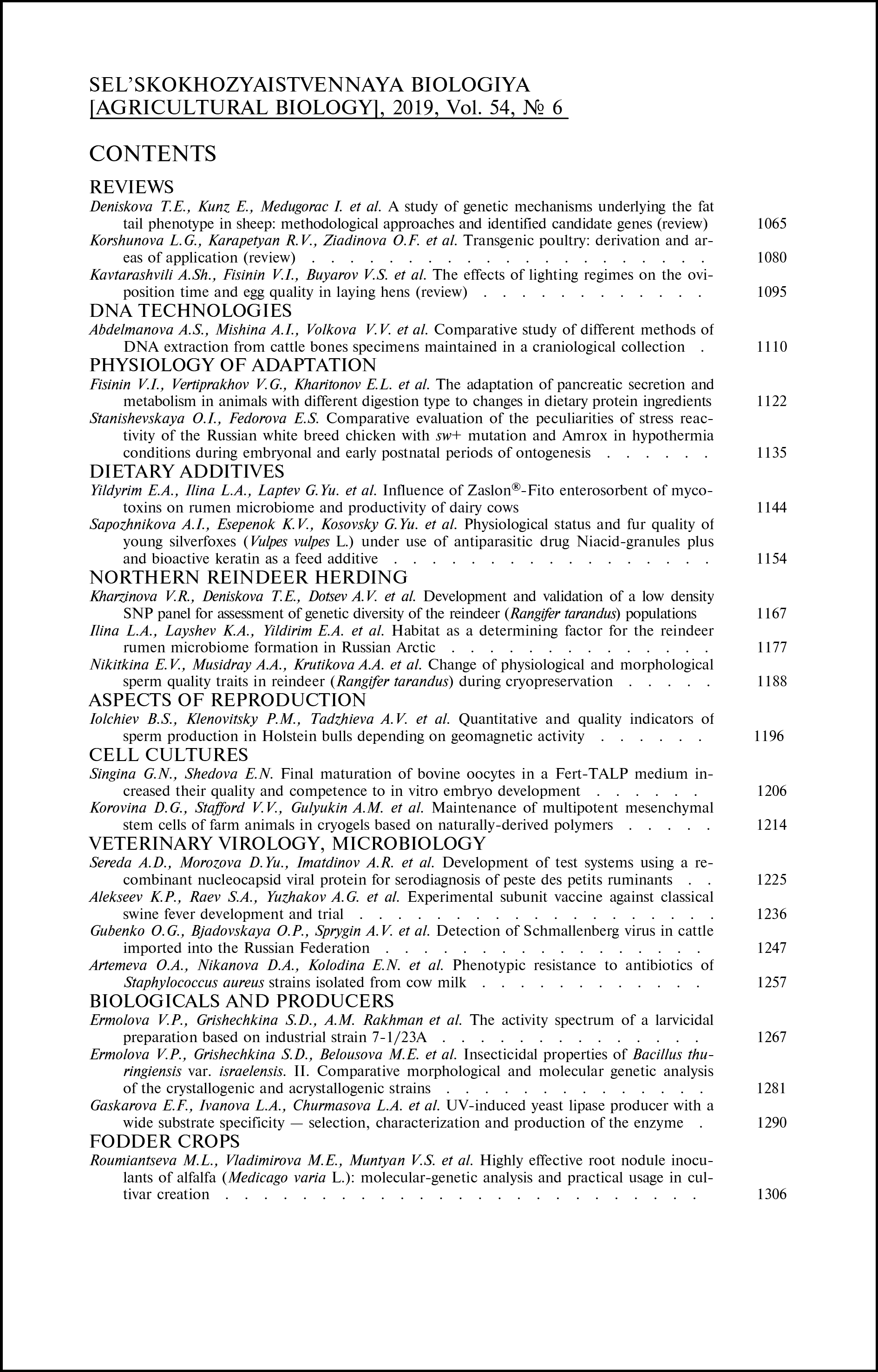doi: 10.15389/agrobiology.2019.6.1188eng
UDC: 636.294:591.16:612.616.2
Acknowledgements:
Supported financially by Russian Science Foundation, project No. 17-16-01023
CHANGE OF PHYSIOLOGICAL AND MORPHOLOGICAL SPERM QUALITY TRAITS IN REINDEER (Rangifer tarandus) DURING CRYOPRESERVATION
E.V. Nikitkina1, A.A. Musidray1, A.A. Krutikova1, S.V. Timofeeva1,
K.V. Plemyashov1, V.V. Goncharov2, S.V. Shabunin3
1All-Russian Research Institute for Farm Animal Genetics and Breeding — branch of Ernst Federal Science Center for Animal Husbandry, 55А, Moskovskoe sh., pos. Tyarlevo, St. Petersburg—Pushkin, 196625 Russia, e-mail nikitkinae@mail.ru (✉ corresponding author), 13linereg@mail.ru, anntim2575@mail.ru, rayo1@yandex.ru, kirill060674@mail.ru;
2Research Institute of Agriculture and Ecology of the Arctic — branch of FRС Krasnoyarsk Science Center, 1, ul. Komsomol’skaya, Norilsk, 663302, Russia, e-mail wgoncharow@mail.ru;
3All-Russian Research Veterinary Institute of Pathology, Pharmacology and Therapy, 114-b, ul. Lomonosova, Voronezh, 394087 Russia, e-mail vnivipat@mail.ru
ORCID:
Nikitkina E.V. orcid.org/0000-0002-8496-5277
Plemyashov K.V. orcid.org/0000-0002-3658-5886
Musidray A.A. orcid.org/0000-0002-0079-9938
Goncharov V.V. orcid.org/0000-0002-9929-746X
Krutikova A.A. orcid.org/0000-0003-2561-145X
Shabunin S.V. orcid.org/0000-0002-2689-6998
Timofeeva S.V. orcid.org/0000-0001-6204-3434
Received August 22, 2019
Assisted reproductive technologies allow effective preservation and use of endangered animal gene pool and creation of new breeding forms. In reindeer (Rangifer tarandus) herding, the technique of sperm cryopreservation is still under development. This is due to the difficulty of collecting reindeer sperm in the Arctic conditions. Besides, the rutting season of reindeer begins in the autumn and lasts about a month. Only during this period is it possible to collect sperm as spermatogenesis in reindeer stops after rutting season. The aim of the work was to study the effects of cooling and freezing-thawing on the physiological and morphological traits of reindeer sperm quality. Reindeer sperm was collected by electric ejaculator or by washing out of the epididymis. After assessing the quality of ejaculated and epididymal semen (volume, total and progressive motility and sperm concentration), the sperm was diluted with Steridyl medium to a final concentration of 100 million/ml, packed in 0.25 ml straws and cooled to 5 °C for 120 min. After cooling and balancing, the straws were kept in liquid nitrogen vapors on a float at -110 °С for 12 min and then lowered into liquid nitrogen. Semen was thawed at 37 °C. The initial assessment of ejaculated sperm showed that the average volume of reindeer ejaculate was 0.5±0.08 ml, with concentration of 0.520±0.069 billion/ml, total motility of 64.3±4.07 %, and progressive motility of 47.9±4.24 %. The epididymal sperm cell concentration was on average 0.260±0.078 billion/ml, total and progressive motility was 43.6±8.49 % and 20.8±5.25 %, respectively. There was a large variability between ejaculates on the extent of changes in sperm motility after cryopreservation. Thus, total motility decreased by 41.9±5.38 % on average with fluctuations from 1 % to 89 %, progressive — by 36.8±5.29 % with fluctuations from 0 % to 75 %. A total of 42 % of ejaculates lost more than 50 % total motility. In some cases, there was a complete loss of motility after freezing, and in some samples the changes were insignificant. Large variability in changing cell motility was observed both in ejaculated and in epididymal semen. Epididymal sperm cells had higher motility after freezing than ejaculated spermatozoa, but showed more pronounced disturbances in the motility character. Sperm morphology analysis showed that there is an increased percentage with wrinkled or missing acrosome as compared to other animal species, i.e. 6.9±0.76 % in both ejaculated and epididymal reindeer sperm cells. There was no significant increase in damages of the sperm tail, neck and acrosome. The number of cells with injuries in tail and neck increased by 4.2±1.05 % with a range from 0.01 % to 15.7 %, and acrosome — by 2.5±0.35 with a range from 0.6 % to 8.3 %. High variability in the increase of plasma membrane damages was observed, i.e. 10.9±5.02 % with fluctuations from 0.13 % to 45 %. Such a large variability is due to the peculiarities of the reindeer sperm cryoresistance and differences between individual ejaculates. Significant difference in physiological and morphological changes in semen quality after cryopreservation between ejaculated and epididymal sperm were not found. Thus, the greatest changes in the cryopreserved reindeer semen are in motility and membrane integrity. The obtained data on physiological and morphological changes in reindeer semen during freezing should be taken into account when optimizing the composition of diluents and cryopreservation protocol.
Keywords: Rangifer tarandus, reindeer, cryopreservation, sperm motility, acrosomes, cell membranes.
REFERENCES
- Laishev K.A., Samandas A.M., Prokudin A.V., Romanenko T.M., Goncharov V.V., Mukhamadeeva T.V. Dostizheniya nauki i tekhniki APK, 2013, 11: 42-44 (in Russ.).
- Goncharov V.V., Nikitkina E.V. Genetika i razvedenie zhivotnykh, 2016, 2: 3-7 (in Russ.).
- Holand Ø., Røed K.H., Mysterud A., Kumpula J., Nieminen M., Smith M.E. Effect of male composition during rut on reproduction and reproductive parameters in reindeer (Rangifer tarandus tarandus). Journal of Wildlife Management, 2003, 67: 25-33.
- Holand Ø., Gjøstein H., Losvar A., Kumpula J., Smith M.E., Røed K.H., Nieminen M., Weladji R.B. Social rank in female reindeer (Rangifer tarandus): effects of body mass, antler size and age. Journal of Zoology, 2004, 263(4): 365-372 CrossRef
- Ropstad E., Veiberg V., Säkkinen H., Dahl E., Kindahl H., Holand O., Beckers J.F., Eloranta E. Endocrinology of pregnancy and early pregnancy detection by reproductive hormones in reindeer (Rangifer tarandus tarandus). Theriogenology, 2005, 63(6): 1775-1788 CrossRef
- Nikitkina E.V., Goncharov V.V., Krutikova A.A., Sergeeva O.K., Musidrai A.A., Plemyashov K.V. Genetika i razvedenie zhivotnykh, 2017, 1: 9-14 (in Russ.).
- Garde J.J., Martínez-Pastor F., Gomendio M., Malo A.F., Soler A.J., Fernández-Santos M.R., Esteso M.C., García A.J., Anel L., Roldán E.R.. The application of reproductive technologies to natural populations of red deer. Reproduction in Domestic Animals, 2006, 41(Suppl. 2): 93-102 CrossRef
- Lindeberg H., Aalto J., Amstislavsky S., Järvinen M., Piltti K., Oksman M., Korhonen H., Vahtiala S., Eloranta E., Pudas T., Nieminen M., Helin A., Reinikainen E., Valtonen M. Development of assisted reproductive technology in the farmed European polecat (Mustela putorius) and in the semi-domesticated reindeer (Rangifer tarandus tarandus). Extended Abstracts of the 28th Congress of the International Union of Game Biologist. Hannover, Germany, 2005: 240-241.
- Dott H.M., Utsi M.N.P. Artificial insemination in reindeer (Rangifer tarandus). Journal of Zoology, 1973, 170(4): 505-508 CrossRef
- Dott H.M., Utsi M.N.P. The collection and examination of semen of the reindeer (Rangifer tarandus). Journal of Zoology, 1971, 164(4): 419-424 CrossRef
- Deryazhentsev V.I. V sbornike: Trudy Magadanskogo zonal'nogo nauchno-issledovatel'skogo instituta sel'skogo khozyaistva Severo-Vostoka [In: Proceedings of the Magadan Zonal Research Institute of Agriculture of the North-East]. Magadan, 1974, tom 4: 30-35 (in Russ.).
- Mkrtchyan M.E., Deryazhentsev V.I. V: Sb. nauchnykh rabot Murmanskoi olenevodcheskoi opytnoi stantsii [In: Collection of scientific papers of the Murmansk reindeer herding experimental station]. Murmansk, 1973, tom 2: 34-36 (in Russ.).
- Mkrtchan M.E., Deryazhentsev V.I. V: Sb. nauchnykh rabot Murmanskoi olenevodcheskoi opytnoi stantsii [In: Collection of scientific papers of the Murmansk reindeer herding experimental station]. Murmansk, 1973, tom 2: 31-33 (in Russ.).
- Lindeberg H., Valtonen M. Ex-situ preservation of endangered species as frozen gametes and embryos. Programme and abstracts of the 10th Nordic Conference on Reindeer Research, 13.-15.3.1998, Kautokeino, Norway. R.E. Haugerud (ed.). Rangifer, 1998, 18(6): 97-98 CrossRef
- Vahtiala S., Lindeberg H., Eloranta E., Säkkinen H. Intrauterine artificial insemination in the reindeer. Programme and abstracts — 11th Arctic Ungulate Conference, 24-28 August 2003, Saariselkä, Finland.R.E. Haugerud (ed.). Rangifer, 2003, 23(3): 67 CrossRef
- Lindeberg H., Oksman M., Järvinen M., Eloranta E., Vahtiala S., Valtonen M. Semen collection in the reindeer (Rangifer tarandus tarandus). In: Book of abstracts for the XII Post Graduate Symposium of Animal Physiology, Research Station of Oulanka, Oulanka, Finland, 7.-9. September 2000. S. Saarela, E. Hohtola (eds.). University of Oulu, 2000, 6: 12.
- Shipka M.P., Rowell J.E., Bychawski S. Artificial insemination in reindeer using frozen-thawed semen. Animal Science, 2010, 88(E-Suppl. 2): 124. Abstract M327.
- Mkrtchyan M.E., Rombe S.M. Zhivotnovodstvo, 1973: 72-74 (in Russ.).
- Plemyashov K., Nikitkina E., Krutikova A., Timofeeva S., Shiryaev G., Musidray A., Goncharov V. Semen collection, evaluation and freezing in reindeer (Rangifer tarandus). Animal Reproduction Science, 2018, 194: e13-e14 CrossRef
- Plemyashov K., Nikitkina E., Lindeberg H., Holand O., Krutikova A., Timofeeva S., Shiryaev G., Musidrai A. Basic semen evaluation in reindeer (Rangifer tarandus). Poster Presentations. Reproduction in Domestic Animals, 2018, 53(S2): 183 CrossRef
- Musidrai A., Plemyashov K., Nechaev A., Nikitkina E., Krutikova A., Timofeeva S., Shiryaev G., Kudinov A., Polteva E., Goncharov V. Analysis of fixing methods of reindeer (Rangifer tarandus) for semen collection. Poster Presentations. Reproduction in Domestic Animals, 2018, 53(S2): 170 CrossRef
- Büyükleblebici S., Tuncerb P.B., Bucak M.N., Ekend A., Sarıözkan S., Taşdemir U., Endirlik B.Ü. Cryopreservation of bull sperm: Effects of extender supplemented with different cryoprotectants andantioxidants on sperm motility, antioxidant capacity and fertility results. Animal Reproduction Science, 2014, 150(3-4): 77-83 CrossRef
- Pezo F., Romero F., Zambrano F., Sánchez R.S. Preservation of boar semen: an update. Reproduction of Domestic Animals, 2019, 54(3): 423-434 (doi.org/10.1111/rda.13389">CrossRef
- Rodriguez‐Martinez H., Wallgren M. Advances in boar semen cryopreservation. Veterinary Medicine International, 2011, 2011: Article ID 396181 CrossRef
- Grötter L.G., Cattaneo L., Marini P.E., Kjelland M.E., Ferré L.B. Recent advances in bovine sperm cryopreservation techniques with a focus on sperm post‐thaw quality optimization. Reproduction in Domestic Animals, 2019, 54(4): 655-665 CrossRef
- Atroshchenko M.M., Kalashnikov V.V., Bragina E.E., Zaitsev A.M. Comparative study of the structural integrity of spermatozoa in epididymal, ejaculated and cryopreserved semen of stallions. Agricultural Biology [Sel’skokhozyaistvennaya Biologiya], 2017, 52(2): 274-281 CrossRef
- Monaco D., Zappia E., Apichaya S., Lacalandra G.M., Thongtip N. Post‐thawing effects of three cryopreservation diluents on Rusa deer (Rusa timorensis) spermatozoa. Reproduction in Domestic Animals, 2019, 54(3): 635-638 CrossRef
- Martínez A.F., Martínez-Pastor F., Álvarez M., Fernández-Santos M.R., Esteso M.C., de Paz P., Garde J.J., Anel L. Sperm parameters on Iberian red deer: electroejaculation and post-mortem collection. Theriogenology,2008, 70(2): 216-226 CrossRef
- Gao D.Y., Critser J.K. Mechanisms of cryoinjury in living cells. ILAR Journal, 2000, 41(4): 187-196 CrossRef
- García-Álvarez O., Soler A.J., Maulen Z., Maroto-Morales A., Iniesta-Cuerda M., Martín-Maestro A., Fernández-Santos M.R., Garde J.J. Selection of red deer spermatozoa with different cryoresistance using density gradients. Reproduction in Domestic Animals, 2016, 51: 895-900 CrossRef
- Esteso M.C., Fernández-Santos M.R., Soler A.J., Montoro V., Quintero-Moreno A., Garde J.J. The effects of cryopreservation on the morphometric dimensions of Iberian red deer (Cervus elaphus hispanicus) epididymal sperm heads. Reproduction in Domestic Animals,2006, 41(3): 241-246 CrossRef
- Atroshchenko M.M., Bragina E.E., Zaitsev A.M., Kalashnikov V.V., Naumenkova V.A., Kudlaeva A.M., Nikitkina E.V. Conservation of genetic resources in horse breeding and major structural damages of sperm during semen cryopreservation in stallion. Nature Conservation Research, 2019, 4(Suppl. 2): 78-82 CrossRef
- Soler A.J., García A.J., Fernández‐Santos M.R., Esteso M.C., Garde J.J. Effects of thawing procedure on postthawed in vitro viability and in vivo fertility of red deer epididymal spermatozoa cryopreserved at -196 °C. Journal of Andrology, 2003, 24(5): 746-756 CrossRef
- Zomborszky Z., Nagy S., Nánássy L., Szabari M., Bodó S. Experiences in deer sperm cryopreservation under practical conditions — a pilot study. Animal Reproduction Science, 2005, 90(1-2): 185-190 CrossRef












